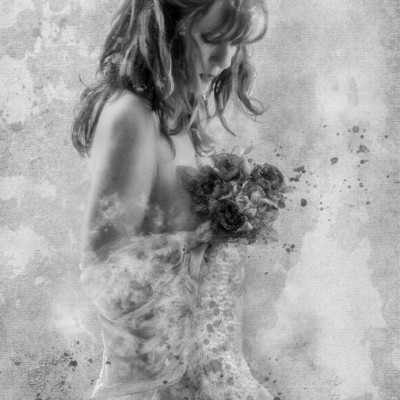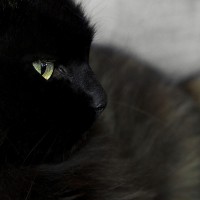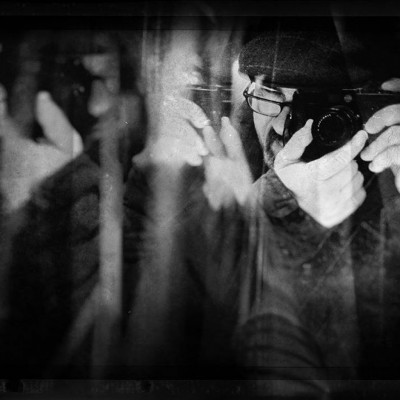SEARCH






|
|
|
|


by Editor Marius Cinteză
“I make photography with my soul, capturing different moments of my life. I see the world differently through the lens of my camera; photography has taught me to notice beauty when sadness surrounds me.” – Cristina Venedict
Cristina Venedict is a fine art photographer based in BotoÅŸani, Romania. She won in 2016 the national prize of the biggest photography competition in the world – Sony World Photography Awards, her photo (“In depth”) being the best photograph of a Romanian artist. Cristina discovered her passion for photography about 9 years ago, after the university graduation, but the love for the visual arts was inherited from her father. Since then she embraced photography with passion and emotion, started to play, experiment and developed herself in many ways so that her life gain a new meaning and she felt that this is what she wants to do.
Apart from Sony Awards she won multiple photography competitions including: PWP’s 37th Anniversary International, Shoot The Face International Portrait Photography Award, TZIPAC, Px3, IPA, 35photo and many more. Also, her works have been exhibited in places such as London, Krakow, Dublin, Vermont, New York, Vienna, Cairo, Rome, Switzerland, Athens, Moscow, India, France (Saint Gilles Croix de Vie) and many more or have been in various publications & websites.
I invite you to discover in the interview below more on Cristina Venedict and be inspired by her creative portraiture works!
Cristina, first I would like to thank you so much for taking your time to answer my questions! To begin, please introduce yourself shortly and tell us more about yourself!
Thank you, Marius, for this opportunity! I am Cristina Venedict, a Romanian photographer based in BotoÅŸani. Shortly, my work is focused more on fine art and environmental portraits and I love to say that I make photography with my soul. I was drawn by the photography since 2007 and it was like a revelation! It was such a wonderful feeling! I had another job at that time, but I wasn’t happy - I felt like it wasn’t the proper place for me to be. Then, everything started after my baby was born in 2010 and I discovered the portraiture and, implicitly, the camera, being eager to learn more about its manual functions. I’ve always been fascinated by people, I like looking at them, studying their characteristics, their reactions, getting to know their stories. I believe each human being is unique, beautiful and unpredictable! I like to play, I enjoy being a child. I’m quite immature sometimes, but this is who I am!
Let’s start from the beginning: can you please tell us about your first photographic projects?
After graduating the university, I spontaneously directed my steps toward the photography. The first years were marked by the photographic collages and then, after 4 years, by the portrait photography.
For many of us photography is either a hobby or a way of life. How would you define your relationship with the photography?
The photography remains a challenge for me. A challenge because I always demand more from me and, in time, I find out that I don't know myself enough. That's what I like and makes me want more from photography. I’ve never dreamt of being a photographer and I haven’t thought I'd ever be one. That until the age of 25. After graduating from the University of Psychology, I felt that my place was not there. I graduated a high school of art and I wanted to head myself towards a job of safe future. I have chosen the psychology and I do not regret it, especially now that it turned that it helps me a lot. Within these years I was painting and drawing sheets, I was adopting the "flower power" hippy style. I have always enjoyed looking at people, I can do it for hours, to study their gestures, anticipate their reactions. Music, fashion magazines, art, films, have been all parts of my universe in that period and parts of my daily activities. I have accumulated a lot of information and the photography came naturally in my life. I felt like we will have a beautiful relationship from the beginning! I used the camera initially just to take pictures of certain places and people and this led me to a dream world. A world where I could do anything, I was no longer guided by the rules imposed by society. That's what I liked, because I can play the game by my own rules!
What would be the most important experience so far that has influenced your steps in photography?
My baby's birth made a transition towards the portrait photography. Until then, the camera was just an object that I was using in Auto mode to make my storytelling pictures.
You once said that “the photography means challenge and passion”. Your experience and the results so far come from overcoming the challenges with your passion. Which aspects of your photographer life so far do you find the most challenging?
Yes, the photography will always be a challenge. Self-improvement, or attempting to self-improve, remains a challenge and the desired goals can be reached by passion. I never dreamed that I would do studio photography, and now here I am! I'm unpredictable, and I like that. I do not know what the future will bring, but if there is a desire for self-improvement through passion, I am glad as a as child to enjoy the unknown!
How do you manage to maintain and grow your passion for photography?
The unpredictable increases the passion. The fact that I do not know what to expect from me, makes me want more. I'm glad to see the photography pull out the creative side of me and challenge it. The stages I've been through for the last 10 years make me see an unknown person in myself. Why did I go through these stages, what I will do in the future? I do not know. I only know that my life is linked to the photography, but I don't know if it will be portrait, abstract or mixed, and this is a challenge!
Can you please describe in a few words your photographer philosophy and mission?
The photography must convey something, you should only press the shutter when you feel the magic of the moment. You feel that you are a beautiful part of the image in front of you and of the whole moment! Photography means to empathize, to resonate with the person you photograph, within the visual atmosphere created. To feel for a few moments that you are part of the this!
What do you think are the top three secret ingredients for a remarkable photograph?
I think that a photo becomes remarkable when it passes the test of time. Let's say that it becomes timeless and that moment is not lost in time.
Cristina, in 2016 you have won the “Romania National Award” prize of the famous photography competition “Sony World Photography Awards” with one of your remarkable portraits: “In depth”. What this prize meant to you and how this recognition influenced your artistic vision?
I think I was lucky to send a photo that resonated with the jury members. I was glad I won this prize, but it did not change anything. It was just a moment of joy.
The mood conveyed by your portrait photography is outstanding! This is where many photographers try to stand out, but very few even succeed. What is your secret and why are you so drawn by this photography type?
Thank you for your appreciation! I think it's a stage only, but I do not want to leave it. The people fascinate me in general. I was staying for hours and looking at people. I liked to anticipate their movements, to imagine different scenarios. I like to experience their naturalness, but also to create stories. Often, a person's physiognomy transposes you into another mood, perhaps unknown to that person, but which inspires me. The photography came naturally and the fact that people are unpredictable to me, makes me to be attracted to the portraiture.
What do you think that makes different your portraiture works? What are the main features of a successful portrait photographer in your opinion?
I'm still working on this. All the time I demand a lot from me, I feel I can do more. I love colours. At the beginning the photography meant 95% of the black and white for me, but now the chromatic occupies an important place. Everything is important. To empathize with the model, anticipate movements, to guide the model towards what you need and feel. To set the right light and ambient... Being a portrait photographer means to empathize with the person in front of you. To see the hidden side and to manage to bring it to light. I am glad when after the photo shooting the models have a different mood, emanating a different energy. That's what I'm glad for... to feel that the photography is touching the soul of the one I photograph! I exhaust myself, I give a lot of myself when I feel the person opening up in front of me. Then we empathize, and the result is something we want on both sides. It's a therapy for the soul most of the time. When I feel like I've done such a beautiful thing, I'm so excited and I feel I'm connected for life with the person I photographed!
The models you work with in your portraits are an important part of the story you want to build and convey to the viewers. How do you choose your models to perfectly fit your story?
Often a simple gesture, a movement of a person, fascinates me and makes me want to photograph. But what I like the most is that I fell that the models often choose me. Maybe they are also recognizing themselves in my photos and that's why the connection is created.
The success of model shooting sessions depends heavily on the model skills, on one hand, but also on your “stage director” skills, on the other hand. How do you manage to successfully communicate with the models, to make them fit in your story and to get the most of the mood from their performance in front of the camera?
I think the communicating with the model is very important. The model needs to feel for a few hours that she's a part who completes the whole story. She needs to be there, present, both physically and mentally, and to disconnect or to transfer her naturalness into the naturalness of the moment. To anticipate and feel that she has an important role in the final picture!
Can you please tell us something more about your workflow for portrait photography?
The inspiration is very important. Also, the composition elements, the model, the music, and the final touch, that being the photo processing.
Where do you look for to find inspiration for the visual stories you want to convey? What inspires you?
The music, the movies, the chromatic contrasts, the art albums, the gestures, the mimics of other people around are sources of inspiration. I also have many images that have been fascinating me since my childhood.
The digital manipulation works from the early period of your photographer carrier (“Wonderland” and “Mystic place”) reveals a fantastic world, populated with amazing characters. How did you come with this idea and why were you drawn to this kind of art?
Everything came by itself. I was walking through the Copou Park (IaÅŸi, Romania) and suddenly I saw a Gavroche-style dressed girl on a bench. Her clothing fascinated me, also her gestures. I felt that her mind, her thoughts, are so far away, in a world where she feels good. Her physical presence was just for those around her, her mind and thoughts were clearly in another world. On a bench nearby were her parents and brothers. They were so different, it was a huge gap between them, hard to explain. Her family life seemed to be needy, while she was inside her dreams, away...That's how it started, and with her "The little pear girl" opened implicitly a world of fairy tales for me. Totally inexplicable at this moment...
Many believe the gear is not very important when the passion for photography is strong. However, can you please share with us what is the gear do you use?
I'm currently using a Nikon full frame camera and I love Lensbaby lenses. They help and simplify my editing work a lot. For the focal length 50 mm fits me best.
What would be your favourite photo from the last years? Please share with us the story behind it.
My favourite work in the recent years is a photo taken in a monastery. I was on a trip with the child during kindergarten. In the agitation of the moment, to see a perfect image in front of your eyes, and to do nothing to get it, only being there, fascinated me and still fascinates me. Seeing people being part of the whole universe they live in, that's what I want to see. It is a strong feeling and difficult to explain.
Who are your favourite photographers or mentors whose works have influenced you and your photography?
In high school, the drawing teacher recommended us Tarkovsky movies. I was deeply impressed! I have an image inspired by his famous “Solaris. “Arizona Dream” is another movie that influenced me and inspired one of my early works. I like symmetry and the colour palette used by Wes Anderson. As a photographer, I like Paolo Roversi.
Now, since we almost reached the end of this interview, I would kindly ask you to share with us your future plans or photographic projects you would like to involve in.
For the future I would like to continue my conceptual portrait works and I also would like to deepen the knowledge of still life photography. And as a wish, I'd love to photograph Björk!
 | Write |
 | Charlaine Gerber PRO Fantastic images, well done, soo beautiful and full of emotion.....thank you for inspiring and sharing! |
 | Marius Cinteza CREW Thank you, Charlaine! :-) |
 | Deborah Gugeri What amazing images. Very enjoyable reading |
 | Marius Cinteza CREW Many thanks, Deborah!! |
 | Adrian Popan PRO Foarte faine cadre, felicitari! |
 | Marius Cinteza CREW Adrian, multumiri! :-) |
 | Miro Susta CREW Excellent interview, beautiful photographs. I enjoyed very much reading the interview-article and viewing the images. Well done. |
 | Marius Cinteza CREW Thank you so much, Miro! Have a great weekend! |